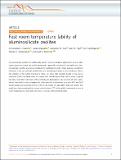Fast room temperature lability of aluminosilicate zeolites
Abstract
Aluminosilicate zeolites are traditionally used in high-temperature applications at low water vapour pressures where the zeolite framework is generally considered to be stable and static. Increasingly, zeolites are being considered for applications under milder aqueous conditions. However, it has not yet been established how neutral liquid water at mild conditions affects the stability of the zeolite framework. Here, we show that covalent bonds in the zeolite chabazite (CHA) are labile when in contact with neutral liquid water, which leads to partial but fully reversible hydrolysis without framework degradation. We present ab initio calculations that predict novel, energetically viable reaction mechanisms by which Al-O and Si-O bonds rapidly and reversibly break at 300 K. By means of solid-state NMR, we confirm this prediction, demonstrating that isotopic substitution of 17O in the zeolitic framework occurs at room temperature in less than one hour of contact with enriched water.
Citation
Heard , C J , Grajciar , L , Rice , C M , Pugh , S M , Nachtigall , P , Ashbrook , S E & Morris , R E 2019 , ' Fast room temperature lability of aluminosilicate zeolites ' , Nature Communications , vol. 10 , 4690 . https://doi.org/10.1038/s41467-019-12752-y
Publication
Nature Communications
Status
Peer reviewed
ISSN
2041-1723Type
Journal article
Description
Charles University Centre of Advanced Materials (CUCAM) (OP VVV Excellent Re-search Teams, project number CZ.02.1.01/0.0/0.0/15_003/0000417) is acknowledged. PN acknowledges the Czech Science Foundation (19-21534S). This work was supported by The Ministry of Education, Youth and Sports from the Large Infrastructures for Research, Experi-mental Development and Innovations project “IT4Innovations National Supercomputing Center – LM2015070”. The UK 850 MHz solid-state NMR Facility used in this research was fund-ed by EPSRC and BBSRC (contract reference PR140003) as well as the University of Warwick including via part funding through Birmingham Science City Advanced Materials Projects 1 and 2 supported by Advantage West Midlands (AWM) and the European Regional Develop-ment Fund (ERDF). Collaborative assistance from the 850 MHz Facility Manager (Dinu Iuga, University of Warwick) is acknowledged. This work was also supported by the ERC (EU FP7 Consolidator Grant 614290 “EXONMR” and Advanced Grant 787073 “ADOR”) and the EPSRC (EP/N509759/1 and EP/N50936X/1). SEA would like to thank the Royal Society and the Wolfson Foundation for a merit award.Collections
Items in the St Andrews Research Repository are protected by copyright, with all rights reserved, unless otherwise indicated.

